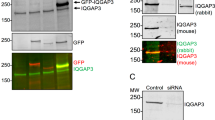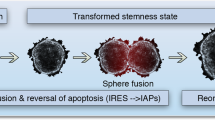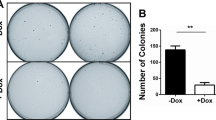Abstract
It has been well known that Ras signaling is involved in various cellular processes, including proliferation, differentiation, and apoptosis. However, distinct cellular functions of Ras isozymes are not fully understood. Here we show the opposing roles of Ha-Ras and Ki-Ras genes in the modulation of cell sensitivity to ionizing radiation. Overexpression of active isoform of Ha-Ras (12V-Ha-Ras) in Rat2 cells increases resistance to the ionizing radiation. Constitutive activation of phosphoinositide-3-kinase (PI3K) and Akt is detected specifically in 12V-Ha-Ras-overexpressing cells. The specific PI3K inhibitor LY294002 inhibits PI3K/Akt signaling and potentiates the radiation-induced apoptosis, suggesting that activation of the PI3K/Akt signaling pathway is involved in the increased radio-resistance in cells overexpressing 12V-Ha-Ras. Overexpression of activated Ki-Ras (12V-Ki-Ras), on the other hand, markedly increases radiation sensitivity. The p38 mitogen-activated protein kinase (MAPK) activity is selectively enhanced by ionizing radiation in cells overexpressing 12V-Ki-Ras. The specific p38 MAPK inhibitor, PD169316, or dominant-negative p38 MAPK decreases radiation-induced cell death. We further show that the mechanism that underlies potentiation of cell death in cells overexpressing 12V-Ki-Ras involves Bax translocation to the mitochondrial membrane. Elevated Bax translocation following ionizing irradiation in 12V-Ki-Ras-overexpressing cells is completely inhibited by PD169316 or dominant-negative p38 MAPK. In addition, introduction of cells with RacN17, a dominant-negative mutant of Rac, resulted in a marked inhibition of radiation-induced Bax translocation and apoptotic cell death as well as p38 MAPK activation. Taken together, these findings explain the opposite effects of Ha-Ras and Ki-Ras on modulation of radiosensitivity, and suggest that differential activation of PI3K/Akt and Rac/p38 MAPK signaling by Ha-Ras and Ki-Ras may account for the opposing response to the ionizing radiation. These data provide an explanation for the diverse biological functions of Ras isozymes, and partly accounts for the differential response of transformed cells to anticancer treatments.
This is a preview of subscription content, access via your institution
Access options
Subscribe to this journal
Receive 50 print issues and online access
$259.00 per year
only $5.18 per issue
Buy this article
- Purchase on Springer Link
- Instant access to full article PDF
Prices may be subject to local taxes which are calculated during checkout







Similar content being viewed by others
Abbreviations
- MAPK:
-
mitogen-activated protein kinase
- MEK:
-
mito-gen-activated protein kinase kinase
- ERK1/2:
-
extracellular-regulated kinase 1 and 2
- SAPK:
-
stress-activated protein kinase
- JNK:
-
c-Jun N-terminal kinase
- PARP:
-
poly ADP-ribose polymerase
- PI3K:
-
phosphoinositide-3-kinase
References
Ahuja HG, Foti A, Bar-Eli M and Cline MJ . (1990). Blood, 75, 1684–1690.
Alapetite C, Baroche C, Remvikos Y, Goubin G and Moustacchi E . (1991). Int. J. Radiat. Biol., 59, 385–396.
Ayllon V and Rebollo A . (2000). Mol. Membr. Biol., 17, 65–73.
Bache M, Pigorsch S, Dunst J, Wurl P, Meye A, Bartel F, Schmidt H, Rath FW and Taubert H . (2001). Int. J. Cancer, 96, 110–117.
Belka C, Knippers P, Rudner J, Faltin H, Bamberg M and Budach W . (2000). Anticancer Res., 20, 3243–3249.
Bernhard EJ, Kao G, Cox AD, Sebti SM, Hamilton AD, Muschel RJ and McKenna WG . (1996). Cancer Res., 56, 1727–1730.
Bernhard EJ, Stanbridge EJ, Gupta S, Gupta AK, Soto D, Bakanauskas VJ, Cerniglia GJ, Muschel RJ and McKenna WG . (2000). Cancer Res., 60, 6597–6600.
Bos JL . (1989). Cancer Res., 49, 4682–4689.
Bossy-Wetzel E and Green DR . (1999). J. Biol. Chem., 274, 17484–17490.
Brooks DG, James RM, Patek CE, Williamson J and Arends MJ . (2001). Oncogene, 20, 2144–2152.
Campbell SL, Khosravi-Far R, Rossman KL, Clark GJ and Der CJ . (1998). Oncogene, 17, 1395–1413.
Cheng A, Chan SL, Milhavet O, Wang S and Mattson MP . (2001). J. Biol. Chem., 276, 43320–43327.
Cheng G and Meinkoth JL . (2001). Oncogene, 20, 7334–7341.
Choi JA, Kim JY, Lee JY, Kang CM, Kwon HJ, Yoo YD, Kim TW, Lee YS and Lee SJ . (2001). Int. J. Oncol., 19, 837–844.
Chuang SM, Wang IC and Yang JL . (2000). Carcinogenesis, 21, 1423–1432.
Crespo P and Leon J . (2000). Cell Mol. Life Sci., 57, 1613–1636.
Cuda G, Paterno R, Ceravolo R, Candigliota M, Perrotti N, Perticone F, Faniello MC, Schepis F, Ruocco A, Mele E, Cassano S, Bifulco M, Santillo M and Avvedimento EV . (2002). Circulation, 105, 968–974.
Datta SR, Brunet A and Greenberg ME . (1999). Genes Dev., 13, 2905–2927.
Desagher S, Osen-Sand A, Nichols A, Eskes R, Montessuit S, Lauper S, Maundrell K, Antonsson B and Martinou JC . (1999). J. Cell. Biol., 144, 891–901.
Eom YW, Yoo MH, Woo CH, Hwang KC, Song WK, Yoo YJ, Chun JS and Kim JH . (2001). Biochem. Biophys. Res. Commun., 285, 825–829.
Fedorov YV, Rosenthal RS and Olwin BB . (2001). J. Cell. Biol., 152, 1301–1305.
Finucane DM, Bossy-Wetzel E, Waterhouse NJ, Cotter TG and Green DR . (1999). J. Biol. Chem., 274, 2225–2233.
FitzGerald TJ, Daugherty C, Kase K, Rothstein LA, McKenna M and Greenberger JS . (1985). Am. J. Clin. Oncol., 8, 517–522.
Galan A, Garcia-Bermejo ML, Troyano A, Vilaboa NE, de Blas E, Kazanietz MG and Aller P . (2000). J. Biol. Chem., 275, 11418–11424.
Ghatan S, Larner S, Kinoshita Y, Hetman M, Patel L, Xia Z, Youle RJ and Morrison RS . (2000). J. Cell. Biol., 150, 336–347.
Goping IS, Gross A, Lavoie JN, Nguyen M, Jemmerson R, Roth K, Korsmeyer SJ and Shore GC . (1998). J. Cell. Biol., 143, 207–215.
Grana TM, Rusyn EV, Zhou H, Sartor CI and Cox AD . (2002). Cancer Res., 62, 4142–4150.
Gupta AK, Bakanauskas VJ, Cerniglia GJ, Cheng Y, Bernhard EJ, Muschel RJ and McKenna WG . (2001). Cancer Res., 61, 4278–4282.
Gupta AK, Bernhard EJ, Bakanauskas VJ, Wu J, Muschel RJ and McKenna WG . (2000). Radiat. Res., 154, 64–72.
Hagemann C and Rapp UR . (1999). Exp. Cell Res., 253, 34–46.
Harris JF, Chambers AF and Tam AS . (1990). Somatic Cell Mol. Genet., 16, 39–48.
Hermens AF and Bentvelzen PA . (1992). Cancer Res., 52, 3073–3082.
Hosoi Y, Miyachi H, Matsumoto Y, Ikehata H, Komura J, Ishii K, Zhao HJ, Yoshida M, Takai Y, Yamada S, Suzuki N and Ono T . (1998). Int. J. Cancer, 78, 642–647.
Johnson DI . (1999). Microbiol. Mol. Biol. Rev., 63, 54–105.
Joneson T and Bar-Sagi D . (1997). J. Mol. Med., 75, 587–593.
Khwaja A, Rodriguez-Viciana P, Wennstrom S, Warne PH and Downward J . (1997). EMBO J., 16, 2783–2793.
Kolch W . (2000). Biochem. J., 351, 289–305.
Kulik G, Klippel A and Weber MJ . (1997). Mol. Cell. Biol., 17, 1595–1606.
Kunz M, Ibrahim S, Koczan D, Thiesen HJ, Kohler HJ, Acker T, Plate KH, Ludwig S, Rapp UR, Brocker EB, van Muijen GN, Flory E and Gross G . (2001). Cell Growth Differ., 12, 137–145.
Lander HM, Milbank AJ, Tauras JM, Hajjar DP, Hempstead BL, Schwartz GD, Kraemer RT, Mirza UA, Chait BT, Burk SC and Quilliam LA . (1996). Nature, 381, 380–381.
Lee SJ, Ha MJ, Lee J, Nguyen P, Choi YH, Pirnia F, Kang WK, Wang XF, Kim SJ and Trepel JB . (1998). J. Biol. Chem., 273, 10618–10623.
Ling CC and Endlich B . (1989). Radiat. Res., 120, 267–279.
McKenna WG, Weiss MC, Endlich B, Ling CC, Bakanauskas VJ, Kelsten ML and Muschel RJ . (1990). Cancer Res., 50, 97–102.
Miller AC, Kariko K, Myers CE, Clark EP and Samid D . (1993). Int. J. Cancer, 53, 302–307.
Nagase M, Alam MM, Tsushima A, Yoshizawa T and Sakato N . (2001). Biosci. Biotechnol. Biochem., 65, 1741–1747.
Nechushtan A, Smith CL, Hsu YT and Youle RJ . (1999). EMBO J., 18, 2330–2341.
Pan J, Xu G and Yeung SC . (2001). J. Clin. Endocrinol. Metab., 86, 4731–4740.
Pennisi E . (1997). Science, 275, 1567–1568.
Pervaiz S, Cao J, Chao OS, Chin YY and Clement MV . (2001). Oncogene, 20, 6263–6268.
Pirollo KF, Tong YA, Villegas Z, Chen Y and Chang EH . (1993). Radiat. Res., 135, 234–243.
Prior IA and Hancock JF . (2001). J. Cell. Sci., 114, 1603–1608.
Radhika V and Dhanasekaran N . (2001). Oncogene, 20, 1607–1614.
Rebollo A and Martinez AC . (1999). Blood, 94, 2971–2980.
Riabowol K, Draetta G, Brizuela L, Vandre D and Beach D . (1989). Cells, 57, 393–401.
Rosenzweig KE, Youmell MB, Palayoor ST and Price BD . (1997). Clin. Cancer Res., 3, 1149–1156.
Santillo M, Mondola P, Seru R, Annella T, Cassano S, Ciullo I, Tecce MF, Iacomino G, Damiano S, Cuda G, Paterno R, Martignetti V, Mele E, Feliciello A and Avvedimento EV . (2001). Curr. Biol., 11, 614–619.
Sklar MD . (1988). Science (Wash., DC), 239, 645–647.
Stadheim TA, Saluta GR and Kucera GL . (2000). Biochem. Pharmacol., 59, 407–418.
Voice JK, Klemke RL, Le A and Jackson JH . (1999). J. Biol. Chem., 274, 17164–17170.
Walsh AB and Bar-Sagi D . (2001). J. Biol. Chem., 276, 15609–15615.
Yan J, Roy S, Apolloniv A, Lane A and Hancock JF . (1998). J. Biol. Chem., 273, 24052–24056.
Yan Z, Chen M, Perucho M and Friedman E . (1997). J. Biol. Chem., 272, 30928–30936.
Yao R and Cooper GM . (1995). Science, 267, 2003–2006.
Yoshino T, Kishi H, Nagata T, Tsukada K, Saito S and Muraguchi A . (2001). Eur. J. Immunol., 31, 2702–2708.
Acknowledgements
This work was supported by a Nuclear R&D Program from the Ministry of Science and Technology in Korea.
Author information
Authors and Affiliations
Corresponding author
Additional information
This work was supported by the Nuclear R&D Program of the Ministry of Science and Technology in Korea
Rights and permissions
About this article
Cite this article
Choi, JA., Park, MT., Kang, CM. et al. Opposite effects of Ha-Ras and Ki-Ras on radiation-induced apoptosis via differential activation of PI3K/Akt and Rac/p38 mitogen-activated protein kinase signaling pathways. Oncogene 23, 9–20 (2004). https://doi.org/10.1038/sj.onc.1206982
Received:
Revised:
Accepted:
Published:
Issue Date:
DOI: https://doi.org/10.1038/sj.onc.1206982
Keywords
This article is cited by
-
PTEN inhibitor bpV(HOpic) confers protection against ionizing radiation
Scientific Reports (2021)
-
A model for RAS mutation patterns in cancers: finding the sweet spot
Nature Reviews Cancer (2018)
-
Effect of 3G Cell Phone Exposure with Computer Controlled 2-D Stepper Motor on Non-thermal Activation of the hsp27/p38MAPK Stress Pathway in Rat Brain
Cell Biochemistry and Biophysics (2014)
-
Oxidation of Biomolecules in the Apoptotic Death of Cerebellar Granule Neurons Induced by Potassium Deprivation
Neurochemical Research (2011)
-
Effects of irradiation on tumor cell survival, invasion and angiogenesis
Journal of Neuro-Oncology (2010)



